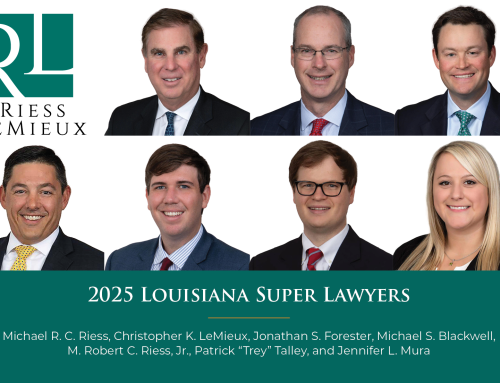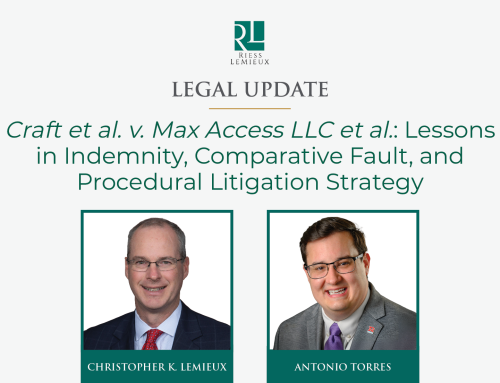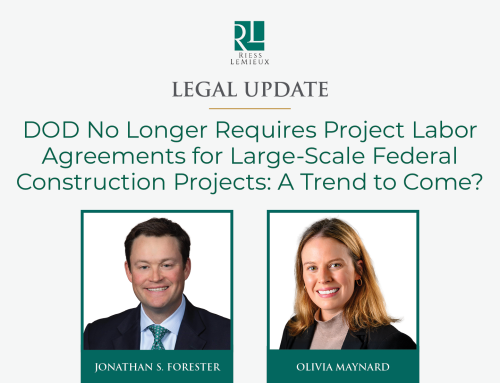A federal appeals court recently vacated an OSHA citation against a contractor for lack of “fair notice” even though the agency had properly interpreted the regulation. In Lake Building Products, Inc. v. Secretary of Labor, 2020 WL 2190772 (6th Cir. May 6, 2020), a contractor argued it did not have “fair notice” that OSHA would impose a citation related to the use of fall protection during erection and connection of steel. After the contractor contested the citation, an administrative law judge (“ALJ”) ruled in favor of OSHA and upheld the citation. On appeal, the Occupational Safety and Health Review Commission (“OSHRC”) declined to hear the contractor’s argument that the citation was improper.
The OSHA regulation at the heart of this dispute is C.F.R. § 1926.760(a)(1), which requires, generally speaking, employees engaged in steel erection (commonly referred to as ironworkers) be required to wear personal fall arrest equipment (harness and lanyard) and to have that fall protection equipment tied off to an anchor point any time they are working at a height over 15 feet. Just before the regulation’s enactment, the Steel Erection Negotiated Rulemaking Advisory Committee recommended an exception to the rule for workers known as “connectors,” who are specially trained to work with incoming loads from hoisting equipment. ironworkers who appeared before the Advisory Committee “uniformly stated that they needed to remain unencumbered when they were working with hoisting equipment and some members recounted personal experiences where they were able to escape collapses and incoming steel only because they were not tied off.” 66 Fed. Reg. at 5246. Accordingly, the final regulation exempted from the fall-protection requirement any ironworker—at heights between 15 and 30 feet—who is working as a “connector,” which the regulation defines as “an employee who, working with hoisting equipment, is placing and connecting structural members and/or components.” 29 C.F.R. § 1926.751.
An OSHA compliance officer, who later acknowledged his own lack of experience with the steel-erection regulations, visited the job site and saw the ironworkers assisting a crane with the hoisting and placing of deck bundles atop the steel frame of a partially completed building 28 feet above the ground. The ironworkers were wearing safety harnesses that allowed them to attach to the structure if they chose and would prevent them from falling. The OSHA compliance officer found their failure to anchor their harnesses was a violation of OSHA’s fall-protection regulations. The contractor contested the citation but the ALJ upheld it on the basis that the workers were only “placing” the decking bundles—rather than “placing and connecting” them—and thus were not “connectors” as defined by the regulation.
At the U.S. Sixth Circuit Court of Appeal, the contractor argued in the over 15 years since the regulation was enacted, it had been recognized and understood that when working with hoisting equipment, the placing and/or connecting of bundles of steel decking incidental to the erection of a multi-story steel structure constitutes “connector” work, thereby allowing ironworker engaged in that activity the discretion to decide whether or not to tie off. The Secretary’s argument centered on its interpretation that the regulation’s phrase “placing and connecting” meant that a worker is a connector only when he is doing both of those things.
On appeal, the Lake Building court ruled in favor of the contractor and vacated the citation and penalty. Interestingly, the court ruled that OSHA’s interpretation of the regulation was technically correct; however, it also found that the contractor lacked “fair notice” of how OSHA construed the regulation. Namely, the correct interpretation required the honoring of “OSHA’s use of the conjunctive “and”—while construing the regulation not to require an impossibility—one must require only a certain temporal proximity between the placing and connecting.” How much that temporal proximity was not analyzed because the contractor at issue failed to connect the steel bundles until weeks later. The Lake Building Court left the issue of whether that interpretation would increase the hazards for Ironworkers for resolution by OSHA or the Secretary.
The Sixth Circuit observed that the question of whether an employer has “fair notice” of the interpretation of a regulation depends on: (1) whether the regulation is inartfully drafted; (2) the common understanding of the regulation in the industry and “commercial practice”; and (3) the pattern of administrative enforcement. The court found that the regulation was inartfully drafted because it could not mean what it literally said (i.e., it is impossible for an ironworker to be both placing and connecting a structural member), thereby creating uncertainty as to what the regulation meant. The court also concluded, based on expert testimony, that the industry interpreted the regulation as did the contractor. Finally, the court found that in the 15 years the regulation was in effect before the instant citation, it had only been enforced once in the manner advocated by OSHA which was then vacated by an administrative law judge. For these reasons, the Sixth Circuit overturned the ALJ ruling and vacated the citation.



